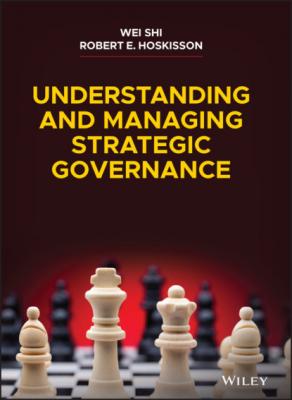ТОП просматриваемых книг сайта:
Understanding and Managing Strategic Governance. Wei Shi
Читать онлайн.Название Understanding and Managing Strategic Governance
Год выпуска 0
isbn 9781119798286
Автор произведения Wei Shi
Издательство John Wiley & Sons Limited
44 44. Zhu, D. H., Shen, W., & Hillman, A. J. (2014). Recategorization into the in-group: The appointment of demographically different new directors and their subsequent positions on corporate boards. Administrative Science Quarterly 59(2): 240–270.
45 45. DesJardine, M. R., Shi, W., & Marti, E. (2020). Board demographic diversity as an opportunity for shareholder activism. Working paper, University of Miami.
46 46. Garg, S., Li, Q. (John), & Shaw, J. D. (2018). Undervaluation of directors in the board hierarchy: Impact on turnover of directors (and CEOs) in newly public firms. Strategic Management Journal 39(2): 429–457.
47 47. Schepker, D. J., Nyberg, A. J., Ulrich, M. D., & Wright, P. M. (2018). Planning for future leadership: Procedural rationality, formalized succession processes, and CEO influence in CEO succession planning. Academy of Management Journal 61(2): 523–552.
48 48. Kowsmann, P. (2020). Commerzbank's CEO and chairman to resign amid pressure from activist Cerberus. Wall Street Journal, www.wsj.com, July 3.
49 49. Arons, S. (2020). Commerzbank names Deutsche Bank's Knof CEO to lead cost cuts. Bloomberg Businessweek, www.bloomberg.com, September 26.
50 50. Chen, K. D., & Wu, A. (2016). The structure of board committees. Boston: Harvard Business School.
51 51. Fredrickson, J. W., Davis-Blake, A., & Sanders, W. G. (2010). Sharing the wealth: Social comparisons and pay dispersion in the CEO's top team. Strategic Management Journal 31(10): 1031–1053.
52 52. Shi, W., Connelly, B. L., & Sanders, W. G. 2016. Buying bad behavior: Tournament incentives and securities class action lawsuits. Strategic Management Journal 37(7): 1354–1378.
53 53. Yanadori, Y., & Cui, V. (2013). Creating incentives for innovation? The relationship between pay dispersion in R&D groups and firm innovation performance. Strategic Management Journal 34(12): 1502–1511.
54 54. Derchi, G.-B., Zoni, L., & Dossi, D. (2020). Corporate social responsibility performance, incentives, and learning effects. Journal of Business Ethics, forthcoming.
55 55. Baysinger, B., & Hoskisson, R. E. The composition of boards of directors and strategic control, 72–87.
56 56. Hoskisson, R. E., & Hitt, M. A. (1988). Strategic control systems and relative R&D investment in large multiproduct firms. Strategic Management Journal 9(6): 506–621.
57 57. Baysinger & Hoskisson. The composition of boards of directors and strategic control, 72–87.
58 58. Miles, R. E., & Snow, C. C. (1978). Organizational strategy, structure and process. New York: McGraw-Hill.
59 59. Hsu, P., Moore, J. A., & Neubaum, D. O. (2018). Tax avoidance, financial experts on the audit committee, and business strategy. Journal of Business Finance & Accounting 45(9/10): 1293–1321.
60 60. Higgins, D., Omer, T., & Phillips, J. (2015). The influence of a firm's business strategy on its tax aggressiveness. Contemporary Accounting Research 32(2): 674–702.
61 61. Carcello, J. V., Hermanson, D. R., & Zhongxia Ye. (2011). Corporate governance research in accounting and auditing: Insights, practice implications, and future research directions. Auditing: A Journal of Practice & Theory 30(3): 1–31.
62 62. Lynall, M. D., Golden, B. R., & Hillman, A. J. (2003). Board composition from adolescence to maturity: A multitheoretic view. Academy of Management Review 28: 416–431.
63 63. Blasi, J., Conte, M., & Kruse, D. (1996). Employee stock ownership and corporate performance among public companies. ILR Review 50(1): 60–79.
64 64. Hart, M. A. (2001). ESOPs in corporate acquisitions: What every buyer should know about the target company's ESOP. Benefits Law Journal 14(1): 9–31.
65 65. NCEO. (2018). A statistical profile of employee ownership. National Center for Employee Ownership. Retrieved from http://www.nceo.org/articles/statistical-profile-employee-ownership.
66 66. Li, J., Shi, W., & Dasborough, M. (in press). CEO positive framing and employee ownership. Human Resource Management.
67 67. Faleye, O., Mehrotra, V., & Morck, R. (2006). When labor has a voice in corporate governance. Journal of Financial and Quantitative Analysis 41(3): 489–510.
68 68. Palladino, L. (2019). Worker representation on US corporate boards. Working paper, University of Massachusetts at Amherst.
69 69. Cobb, J. A. (2015). Risky business: The decline of defined benefit pensions and firms' shifting of risk. Organization Science 26(5): 1332–1350.
70 70. Baldwin, T. (2019). Text -S.915 – 116th Congress (2019–2020): Reward Work Act.
71 71. Holmberg, S. R. (2019). Workers on corporate boards? Germany's had them for decades. New York Times. Retrieved from www.nytimes.com/2019/01/06/opinion/warren-workers-boards.html.
72 72. PwC's 2019 Annual Corporate Directors Survey. (2019). The collegiality conundrum: Finding balance in the boardroom. www.pwc.com/acds19.
Конец ознакомительного фрагмента.
Текст предоставлен ООО «ЛитРес».
Прочитайте

